What are mashed potatoes?
Mashed potatoes are a common side dish widely consumed in different parts of the world. They can be served as an accompaniment with other main dishes or as a standalone dish. There are many variations of mashed potatoes, but the most common one uses boiled, peeled and chopped or grated potatoes that are beaten and seasoned with butter, salt and pepper.
A Homemade Mashed Potatoes Recipe The Ultimate Comfort Food
What's Not To Love About Mashed Potatoes!
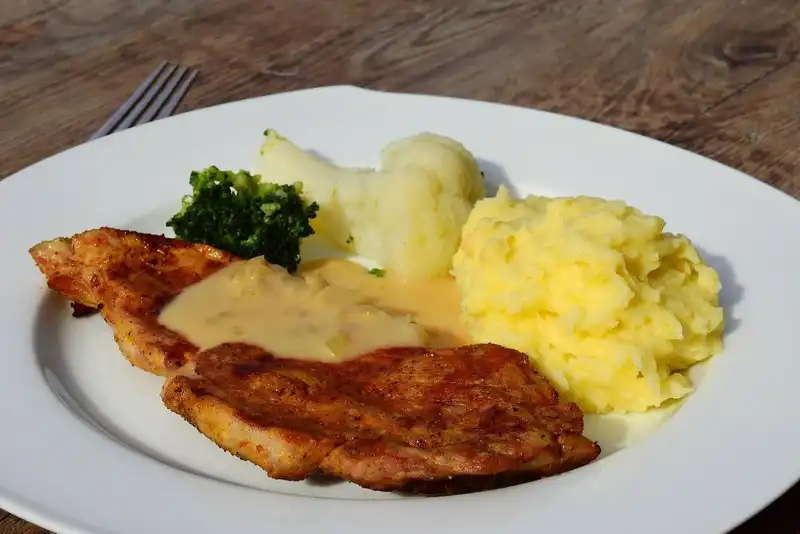
Think of a dish that leaves you licking your fingers and begging for a second helping. Do mashed potatoes come to mind? Of all the delectable dishes that can be made using the good old tuber, there's nothing more comforting than potato mash.
Research has it that mashed potatoes help in the release of the neurotransmitter serotonin, which is linked to good mood. And so potatoes generally, and mashed potatoes, in particular, have a reputation for easing depression. According to a US National Library of Medicine article, a meal rich in carbohydrates raises the level of serotonin synthesis.
Although it is believed that mashed potatoes first appeared in England in the 1600s, the dish may actually be much older. The consumption of potatoes goes back over 6,000 years to ancient Peru, with the Incas likely being the first people to mash potatoes. In fact, research even suggests of all the South American Indians who consumed potatoes, the Incas were the ones who liked them mashed.
The way potatoes are prepared differs from one culture to another. For example, mashed potatoes in India are enriched with a variety of spices, including chili powder, cinnamon, coriander, cumin, and cloves, then stuffed inside a bun and served with roasted peanuts, tamarind pickle, and pomegranates. French mashed potatoes, on the other hand, include an egg yolk.
The first mashed potato recipe, according to some sources, emerged in 1771 during a competition held by a Frenchman named Antoine Parmentier, who was a potato enthusiast.
While this humble dish is popular throughout the year, mashed potatoes gain special significance at Thanksgiving dinners in the US, when they sit proudly alongside the turkey, cranberry sauce, candied yams, and pumpkin pie.
How to Choose the Right Spuds for Your Mashed Potatoes
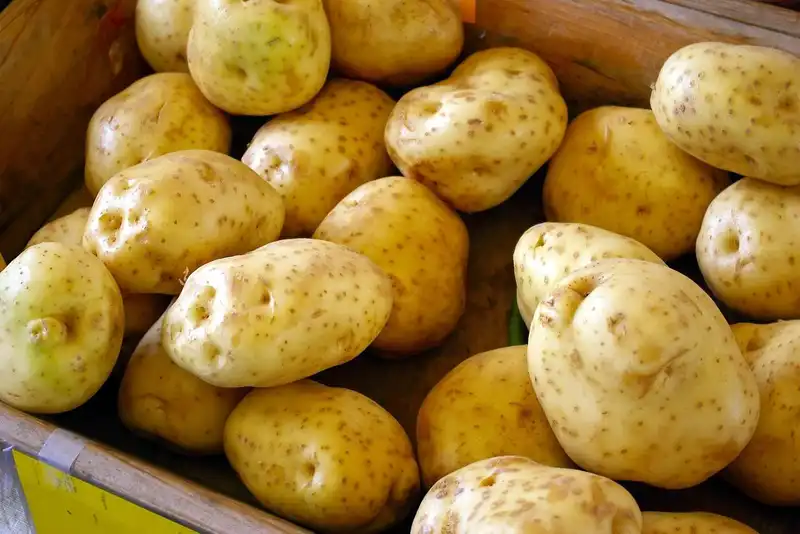
Anybody looking to make a superior mashed potato dish needs to first find the right potatoes. The wrong type can ruin the dish, no matter how hard you try to salvage it by using cream, butter, or white pepper later.
The Yukon Gold variety is widely considered to be ideal for making mashed potatoes. They are halfway between starchy and waxy and have an inherent creamy, buttery flavor. In addition, Yukon Gold potatoes also have the densest flesh among all the potato varieties. The result is a solid, meaty mound of potato mash with a velvety texture and lip-smacking flavor. These potatoes are known to absorb a lot less water than other varieties, so your mashed potatoes won't turn out gummy or mushy.
Russet potatoes are often used as an alternative to Yukon Golds. However, they are a bit tricky to use. Since they contain more starch than Yukon Golds, Russets soak in water more readily. This makes it imperative for these potatoes to be dried thoroughly after boiling in order to avoid the mash from turning watery and tasteless.
There are other, lesser-known options too. Dutch cream potatoes can be used for potato mashes, given their creamy texture. The Desiree and Australian Toolangi Delight potatoes are also good options. Although the Desiree variety is a bit waxy, it is creamy enough to be mashed.
You can also mix varieties, like Yukon Golds and Russets, when making mashed potatoes. This way, you get the best of both worlds. While the Yukon Gold is more moist and waxy and maintains its form better than the Russet, the latter cooks quicker, is more fluffy and starchy and is less sweet. Moreover, Yukon Golds have a naturally creamy flavor, whereas Russets are 'empty canvases' that soak up all the milk, butter, and cream you put into the pot.
It is also important to choose well-formed, loose potatoes that are also firm, smooth, have eyes, and are free of soft patches, bruises, and discoloration. Green potatoes may have a bitter taste and need to be avoided.
Mashed potatoes are delicious, but it can be difficult to find a healthy recipe that doesn’t require a lot of time or effort.
Homemade mashed potatoes are a comforting dish, and we make them easy. Our simple recipes are nutritious, delicious, and takes only minutes to prepare.
Why Homemade Mashed Potatoes Beat the Store-Bought Stuff
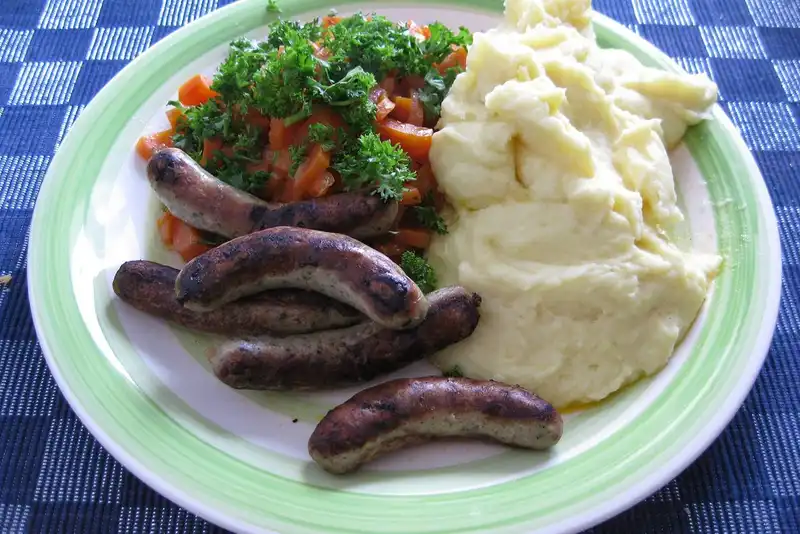
Once you have chosen the right potatoes, get down to making your own mashed potato. Food experts and nutritionists advise against buying instant mashed potatoes from the market, notwithstanding the taste they may be packed with.
The sodium contained in just one serving of boxed mashed potatoes is as high as 440 mg. This is roughly 25% of one's daily maximum recommended sodium intake, according to Nutritionist Lisa Richards, author of the book The Candida Diet. The additional seasoning with butter and salt that mashed potatoes need tends to increase their sodium content even more. Excess sodium in the diet can cause high blood pressure, and damage the kidneys, nervous system, heart, and even the brain.
Moreover, store-bought mashed potatoes contain double the calories per cup provided by whole potatoes. Even if you stick to the serving size recommended by most brands, which is 1/3 cup per serving, instant mashed potatoes could cause you to put on around 66 calories, while the more modest homemade stuff would give you just 33 calories. Additionally, most of the calories contained in store-bought mashed potatoes are derived from harmful saturated fat.
Non-instant potatoes provide small amounts of calcium, which contribute to bone health. Store-bought mashed potatoes, however, lack calcium. Worse still, you are completely in the dark about what goes into a box of store-bought mashed potatoes. These food items contain stabilizers and additives that ensure long shelf-life and flavor but may harm consumers in the long run. What's more, the non-organic stabilizing and bulking agent silicoaluminate can be potentially toxic, according to Richards.
When you make mashed potatoes at home, you can control the quantity and quality of ingredients you put into the dish, using leaner ingredients to make your meal healthier. For instance, you can skip the butter, which is packed with saturated fat, and put in eggs instead to enrich the preparation without making it heavy. Eggs provide a custard-like texture and can be a good replacement to milk.
Ingredients for Your Garlic Mashed Potatoes
Garlic mashed potatoes tops our list of favorite (and healthy) potato recipes. Use Yukon Gold potatoes for their creamy texture. This will reduce the need to add extra cream and butter. Make sure the potatoes aren't too long, which may make them lumpy. Check their softness by poking them with a fork.
Use a whole head of garlic, but roast it first to bring out its full flavor.
Mashed potatoes can be delicious even when they are not calorie-rich cream bombs. A good way to keep calories under control is by using whole milk. If you want to go dairy-free, replace butter with extra olive oil, and use chicken or vegetable broth as an alternative to cream. Vegans can use unsweetened, non-dairy milk and vegan butter.
Avoid using a food processor or blender as these tools may make the mashed potatoes gummy. However, some of the equipment that you do need to use are the potato masher, food mill, potato ricer, stand mixer or hand mixer, fork, and elbow grease.
Here are the ingredients you need for the perfect homemade garlic mashed potatoes-
- 1 head of unpeeled and whole garlic
- 2 pounds of potatoes (ideally Yukon Gold or some other waxy, yellow potato)
- 1 tablespoon of extra virgin olive oil
- 1/2 teaspoon of salt. Add more according to your taste
- 3 tablespoons of butter
- 1/3 cup of cream
How to Make Garlic Mashed Potatoes
- Preheat your oven to 400 F.
- Take off the external layer of the garlic head's papery skin, but leave the head intact. Cut the tops of the garlic cloves with a paring knife. Place the garlic head on aluminum foil. Drizzle some olive oil over it, salt it lightly, and gently wrap the garlic in the foil. Bake for 30-40 minutes at 400 F, or till the garlic cloves turn soft and start to brown. Remove them from the oven, and let them cool down.
- While the garlic is roasting, peel the potatoes and cut them into chunks measuring an inch each. Put the potato chunks in a medium-sized saucepan, add half a teaspoon of salt, and cover them with cold water. Bring the water to a boil, and then lower the heat to let the potatoes simmer for about 15 minutes or until they feel tender when poked with a fork.
- Combine the butter and cream either in a bowl in the microwave oven or in a small pan on top of the stove. Cook over a low flame to melt the butter and warm the cream.
- Drain the saucepan with the potatoes, and put it back on the stove. Keep the heat low. Add the drained potatoes back into the pot. Add the roasted garlic to the potatoes by squeezing them in. Use either a fork or a potato masher to mash the potato.
- Add the butter and cream and mash the potatoes until they reach the desired consistency. Be careful not to over-beat the potatoes so that they don't become sticky. Feel free to add extra salt if required.
Homemade mashed potatoes can be time-consuming and tricky to make.
It’s not always easy to find the right kind of potatoes, and they can be expensive.
Best Served With . . .
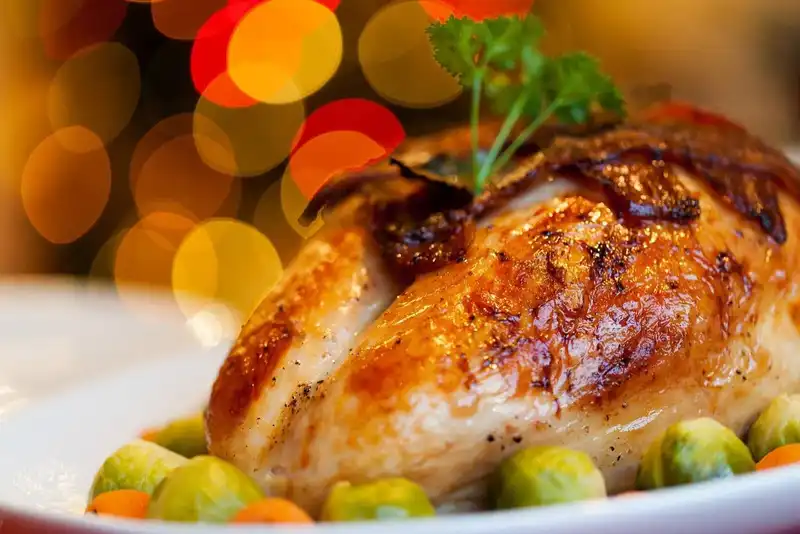
A creamy mashed potato side dish can be paired with a wide array of mains.
First on the list has to be turkey. There's good reason the classic Thanksgiving meal puts the two together. Mashed potatoes make an ideal side dish with corned beef too, absorbing the rich flavors of the beef. They also add to the goodness of beef bourguignon, an extremely comforting preparation of tender beef chunks in red wine. Pork chops and pork gravies also readily accept mashed potatoes as a side dish. However, we believe the best pairing is mashed potatoes and fried or roasted chicken.
Mashed potato can also be served with catfish, fish cakes, meatballs, barbecued pork or chicken, instant pot chicken thighs, beef stroganoff, and slow cooker Salisbury steak.
Cooking Tips and Tricks
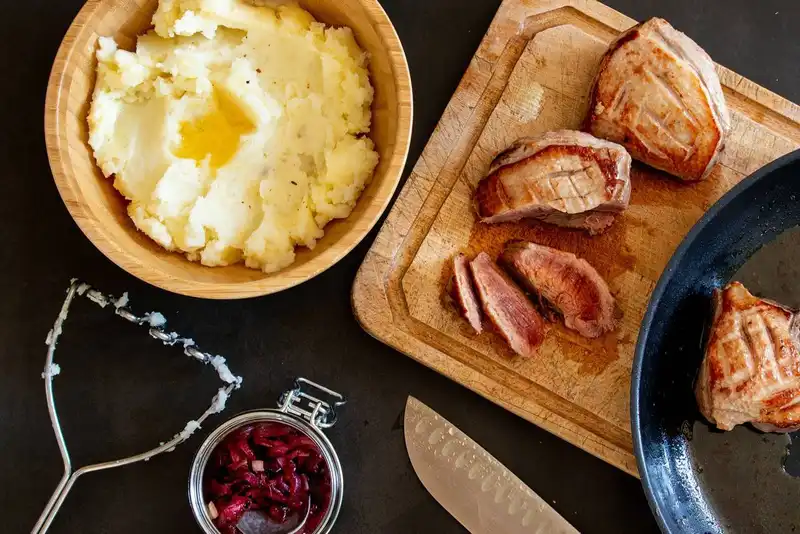
If you want to whip up the best mashed potatoes in town, make sure you follow these tips. . .
- When boiling your potatoes, see to it that the chunks are large. When cut thin, water enters the potato more easily, and you'll have a watery mash that tastes bland. Another way to prevent your taters from absorbing too much water is to boil them unpeeled.
- Add salt to the water once it comes to a boil. The salt will be absorbed by the starch as the potatoes boil, adding to the flavor of your taters. Potatoes require a substantial amount of salt.
- Don't wait for the potatoes to cool before mashing them. This will prevent you from getting a genuinely creamy flavor and texture.
- Add the fats (butter and cream) before you add the liquids if you want the texture of the potatoes to be firm.
- Potatoes aren't able to soak in large additions of liquid all at once. To prevent your mashed potatoes from turning runny, opt for smaller pours.
- Allow the butter to slightly melt and the milk to come to room temperature before adding them to the mashed potatoes. The potatoes will be able to absorb them more readily as a result. Don't use cold ingredients with warm taters.
- To cook potatoes evenly, make use of cold water, gently bringing it to a boil. Also, the tater pieces should not be more than 3/4 inches thick.
- Avoid over-mashing. When potatoes are mashed, starch is released. When mashed for too long or too vigorously, a lot of starch is generated, making the potatoes gluey and tasteless.
Where Spuds Stand Today
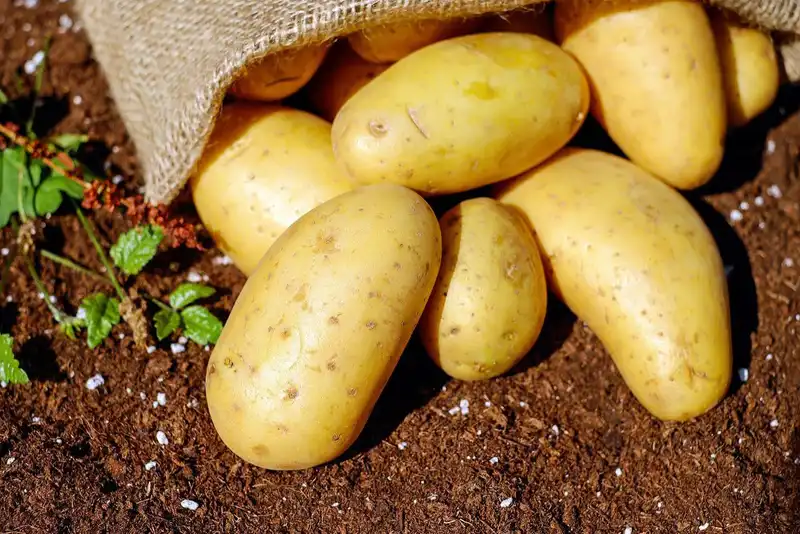
Potatoes are probably the most underrated food you have in your kitchen. These humble tubers may not have the glamor of turkey or beef but are extremely versatile.
Potatoes can be mashed, baked, roasted, fried, boiled, used to make chowders and soups, and can play an important (though commonly overlooked) role in candies, cakes, and cookies. The unassuming spud can take centerstage in a dish, or play second fiddle as a side dish with equal aplomb.
Potatoes are so ubiquitous in our lives that they tend to be taken for granted, and you don't often realize that potatoes are the main constituents of some of America's most favorite food products, from French fries, and mashed potatoes to tater tots, and hash browns. Potatoes have become an integral part of our lives so much so that every year, an average American consumes 140 pounds of the tuber annually.
Sadly, however, potatoes have not been treated well. Potatoes were among the most wasted food products globally in 2016, according to the Food and Agriculture Organization (FAO). A whopping three billion pounds of them are discarded every year at the global level. According to a report on earth.org, the US throws away 5.8 million potatoes every year. In fact, over half of all the vegetables and fruits grown in the US go to waste, and most of this wastage happens at the Food Production stage.
(The US has one of the highest rates of Food Waste in the world 103 million tonnes in 2018. Every day, an average American throws away nearly a pound of food.)
Potatoes are often tossed away when they become unattractive. So potatoes that have sprouted, developed wrinkles, gone green or soft, are often discarded. Concerned about Food Safety, people discard potatoes that have browned or are found to be bruised, even though they are perfectly safe for consumption.
When you want mashed potatoes, but don’t have the time or energy to make them.
The thought of making the perfect mashed potato is enough to make you want to throw in the towel.
